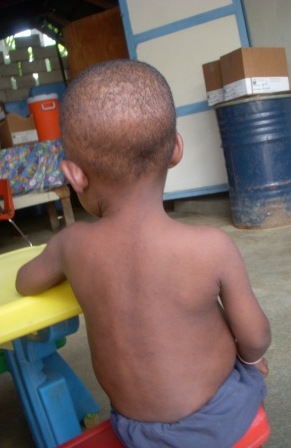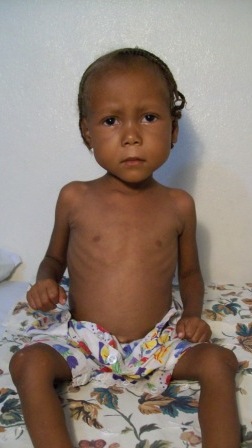You can click on part 1 and part 2 to read the begnning of Graham Sowa’s paper.
b. data from Real Hope for Haiti clinic in Cazale, Haiti
The Real Hope for Haiti clinic is located in Cazale, Haiti, about 40 km north of the capital, Port-au-Prince.
Between May of 2008 and February of 2011 the clinic treated 188 patients suffering from malnutrition and/or undernutrition with Medika Mamba. These patients were all treated within the clinic over the course of 4-10 weeks until they either died or were discharged.
Of the 188 patients, 155 (88%) were five years of age or less. The remaining 23 (12%) patients ranged from 6 years old to 70 years old.
All of the patients were suffering from malnutrition which was usually diagnosed as kwashiorkor complicated by marasmus. This can be seen in the height for weight ratios (Z-scores) of the patients.
| Z-Score (standard deviation) | Number of patients | Percent of patients |
| -3 SD | 96 | 51% |
| -2 SD | 35 | 19% |
| -1 SD | 24 | 13% |
| SD Median | 13 | 7% |
| +1 SD | 3 | 2% |
| +2 SD | 3 | 2% |
| Unknown | 14 | 7% |
The presence of the clinical signs of kwashiorkor (edema, etc.) in 149 patients (79%) also shows that protein malnutrition was also present. The majority (51%) of patients had z-scores of -3 standard deviations (or worse). This shows that this group of patients was particularly advanced in their disease and their malnutrition had severely compromised their ability to grow along their growth curve.
Of the 188 patients that started the treatment, 149 (79%) completed the treatment and were discharged after recovering from the symptoms of kwashiorkor and reaching a z-score in line with their growth curve. Regardless of the cause of mortality 39 patients died during treatment (21%). Of these patients that died, 27 (69%) of them died during the first month of treatment. Early successful intervention is obviously critical.
c. comparison of research data from studies and clinical data from the Real Hope for Haiti clinic
The data of the Medika Mamba treatment program from the Real Hope for Haiti Clinic differs from the controlled trials that were cited above in several distinct ways.
First, the data from the Real Hope for Haiti Clinic is from a treatment setting without a control group, thus the data is not experimental and does not test a hypothesis. Instead its value is from the actual application of the treatment regime rather than a highly controlled study. This allows us to examine the success of Medika Mamba as a treatment strategy in non-research context.
Second, the data is from inpatient treatment. All patients lived at the Real Hope for Haiti Clinic during their treatment with Medika Mamba. One of the values of Medika Mamba is that it can be administered by a parent in the home, outside of the clinic. At home therapy could be an option in the future; however, many of the patients were in advanced stages of their disease and required 24 hour care.
Third, the majority of the patients that did not survive died within the first month of treatment (69%). This shows that the critical time period for success is within the first month of treatment. Treatment variables should be identified and examined to determine on how to ensure survival of more patients through the first month of treatment.
Finally, more clinical data should be analyzed to compare daily weight gain and identify key points in treatment where success or failure is related to death. Obviously, the first month of treatment should be of particular focus for further investigation and more medical intervention strategies should be considered for the most severe cases of malnutrition.
I. discussion
The discussion of the different treatment methods for malnutrition and undernutrition will be evaluated with respect to economic, social, and political peculiarities. The aim of this discussion is to bring multiple perspectives into the treatment of malnutrition and undernutrition in addition to clinical data.
a. economics of Medika Mamba vs. milk based formula treatments
Medika Mamba is produced in Haiti by a non-governmental organization called “Meds and Food for Kids”. Local product is achieved using peanuts grown and processed by local farmers. Other macronutrients and micronutrients are imported to be mixed with the processed peanut butter.
Local production offers a new market for Haitian farmers to sell their peanuts, as well as jobs in the manufacturing and distribution of Medika Mamba and similarly produced local treatments. This is an example of using foreign aid as a tool for development.
Previous formula based treatments, such as the World Health Organization recommended F100, had to be imported. This importation of such a simple and basic medical treatment such as food does not contribute to development locally and encourages exploitation of starving human beings by companies that produce such formulas.
b. social: inpatient treatment vs. outpatient treatment
As stated above, Medika Mamba can be used as a treatment in a clinical (inpatient) setting or in a home or community (outpatient) setting. Careful thought should be given to determine which setting is best for the patient’s treatment.
The social impacts of inpatient treatment vs. outpatient treatment should be used to determine the best treatment setting for the patient to achieve a good health outcome. Treatment at home can promote family solidarity, build local health knowledge, and offer more vigilant care. Home and community based treatment can also present risks of treatment failure such as a failure to recognize complicating illnesses, a failure of the family to care for their child, and multitudes of problems that exist in communities with low levels of solidarity and high levels of inequality.
Inpatient treatment is resource intensive and requires many skilled and motivated staff. Ready to use therapeutic foods and are designed to increase access to services, reduce opportunity costs, encourage early presentation and compliance, and thereby increase coverage and recovery rates. In community-based therapeutic care, all patients without complications could be treated as outpatients. (Collins, Dent, Binns, Bahwere, Sadler, & Hallam, 2006)
The debate between inpatient and outpatient treatment must also take into account the complications of severe, chronic malnutrition. These patients often present with other complicating diseases. While an outpatient treatment might use fewer resources, this should not come at the expense of good health outcomes.
c. political
Currently, Medika Mamba is manufactured by a private non-governmental organization. The cost of the product is prohibitive to the average rural Haitian and probably no one suffering from severe malnutrition could afford to pay for the product. Therefore, the treatment is paid for by charity, non-governmental organizations, or the state.
Local political institutions should be vigilant to ensure that citizen’s rights are being protected and fair access to treatment with these new ready to use therapeutic food is ensured. Political organizations and governments should look into the possibility of producing such treatments locally and with public resources and funds.
Local political organizations should consider making distributors of such products use local resources for production. Governments should also require that distributors and producers make the formulas for their treatments publically available to ensure the possibility of local competition. This would avoid monopolistic tendencies of the industrial aid complex.
Conclusion
This paper began with an examination of the effects of malnutrition on the developing nervous system. We saw the impacts of macronutrient malnutrition on the nervous system and their documentation through clinical studies and electronic imaging over the past 50 years. While these impacts are clear and dangerous, they are also mostly reversible with successful medical intervention. This intervention has traditionally been done with powder based formulas that have proven successful in many instances but also have disadvantages that should be improved upon. Medika Mamba and similar ready to use therapeutic foods resolve many of these disadvantages. As new products, they have been successfully tested in several African countries and deployed in Haiti. As with all medicine, there are economic, social, and political implications that should be discussed. One key recommendation is that governments should become more involved to ensure the use of new treatments continue to serve the society and are not controlled by aid industry and non-governmental monopolies.








Comment(1)
Debbie Woodward says
November 7, 2011 at 5:25 pmThank you for writing this. I love learning more so that over time, more children can receive the nutrition they need. So glad you are taking a closer look at the outcomes.